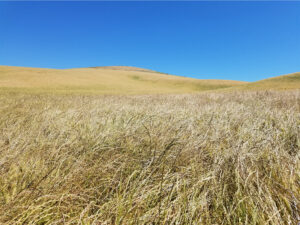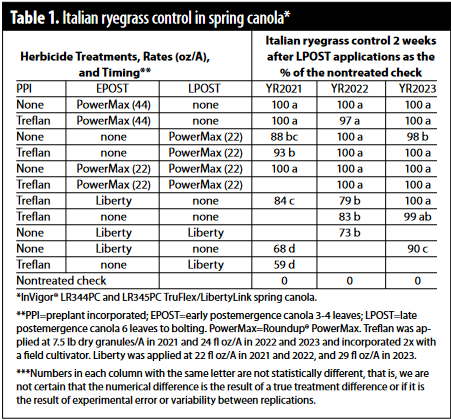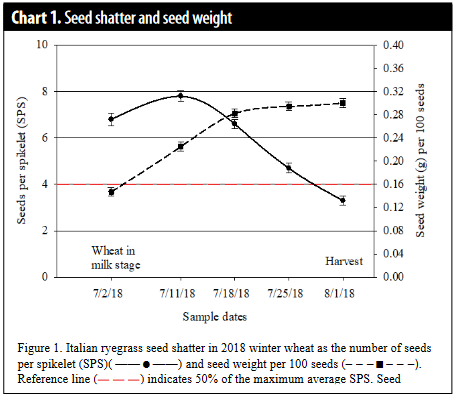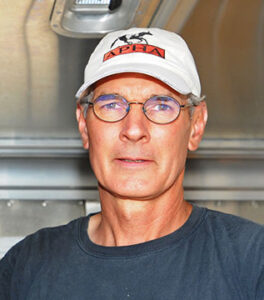Italian ryegrass management in wheat cropping systems
By Mark Thorne and Drew Lyon
“Ryegrass wasn’t a problem 30 years ago, we just kept using Hoelon[1], until it didn’t work anymore.” That was the message I heard from a Pullman-area farmer a couple of years ago when we were working to understand patterns of ryegrass seed shatter in wheat crops. This farmer spoke from wisdom, experience, and a deep concern over the future of farming as he was keenly aware that Italian ryegrass was going to change farming for him as well as all his neighbors.

Italian ryegrass (Lolium perenne L. ssp. multiflorum (Lam.) Husnot) is a feral version of annual ryegrass, which is sold in lawn seed mixes and ground cover mixes to prevent soil erosion on road cuts and construction areas. In Oregon’s Willamette Valley, it is grown for seed and for winter pasture for sheep and cattle. However, in Eastern Washington, Italian ryegrass is a serious weed in the mid- to high-rainfall areas, not just because it can substantially reduce crop yield, but because it is now genetically resistant to many of the herbicides that once controlled it, and it has the potential to become resistant to all the herbicides that are still effective. This is more than just concerning; this is a highly probable outcome. Compounding this issue is the reality that the development of new herbicide chemistries is limited in the near future.
 Management of Italian ryegrass in wheat cropping systems needs to include all weed control strategies. Herbicides applied in wheat have shown mixed results. Group 15, pyroxasulfone (Zidua or Anthem Flex), which needs rain for activation, is most effective when applied preemergence or just when Italian ryegrass coleoptiles begin to emerge, with control averaging 80% or greater. Products that combine pyroxasulfone with flumioxazin, Group 14, (Fierce) have also been effective. However, Group 1 and Group 2 herbicides are largely ineffective where resistance has developed. Some examples of Group 1 herbicides include Aggressor AX (quizalofop), a component of the CoAXium wheat production system, and Axial XL (pinoxaden). Some examples of Group 2 herbicides include Beyond (imazamox), a component of the Clearfield Plus production system for wheat, Osprey Xtra (mesosulfuron + thiencarbazone), PowerFlex HL (pyroxsulam), and Outrider (sulfosulfuron). To delay or prevent developing more resistance, combining and/or rotating sites of action is critical.
Management of Italian ryegrass in wheat cropping systems needs to include all weed control strategies. Herbicides applied in wheat have shown mixed results. Group 15, pyroxasulfone (Zidua or Anthem Flex), which needs rain for activation, is most effective when applied preemergence or just when Italian ryegrass coleoptiles begin to emerge, with control averaging 80% or greater. Products that combine pyroxasulfone with flumioxazin, Group 14, (Fierce) have also been effective. However, Group 1 and Group 2 herbicides are largely ineffective where resistance has developed. Some examples of Group 1 herbicides include Aggressor AX (quizalofop), a component of the CoAXium wheat production system, and Axial XL (pinoxaden). Some examples of Group 2 herbicides include Beyond (imazamox), a component of the Clearfield Plus production system for wheat, Osprey Xtra (mesosulfuron + thiencarbazone), PowerFlex HL (pyroxsulam), and Outrider (sulfosulfuron). To delay or prevent developing more resistance, combining and/or rotating sites of action is critical.
 Controlling Italian ryegrass in all phases of the crop rotation is equally important. Reducing the number of seeds entering the seedbank will help reduce population density in future years. In our region, Italian ryegrass can still be controlled in canola as glyphosate-resistant ryegrass has not yet developed but does exist in orchards in both Oregon and Washington. In our research, glyphosate (PowerMax), Group 9, is very effective for Italian ryegrass control when applied to Roundup Ready TruFlex canola (Table 1); however, relying solely on glyphosate increases the potential of developing glyphosate-resistant ryegrass.
Controlling Italian ryegrass in all phases of the crop rotation is equally important. Reducing the number of seeds entering the seedbank will help reduce population density in future years. In our region, Italian ryegrass can still be controlled in canola as glyphosate-resistant ryegrass has not yet developed but does exist in orchards in both Oregon and Washington. In our research, glyphosate (PowerMax), Group 9, is very effective for Italian ryegrass control when applied to Roundup Ready TruFlex canola (Table 1); however, relying solely on glyphosate increases the potential of developing glyphosate-resistant ryegrass.
An effective strategy for delaying resistant ryegrass is to target two effective sites of action. Applying a preplant Group 3 herbicide like trifluralin (Treflan HFP) can help reduce the number of plants that the postemergence glyphosate application will encounter. Also, glufosinate (Liberty 280 SL), Group 10, can be used in place of glyphosate in LibertyLink canola, but works best when combined with an herbicide that targets a different site of action. In addition, controlling early flushes of Italian ryegrass before seeding reduces the number of plants that in-crop herbicides encounter, which will help increase overall control (see results from YR2023 in Table 1).
Controlling Italian ryegrass in pulse crops is a greater challenge than in canola because of the resistance to Group 1 herbicides and the lack of any glyphosate-resistant cultivars. Currently, Group 15 S-metolachlor (Dual II Magnum) and Group 14 flumioxazin (Valor EZ) provide control and suppression, respectively, of Italian ryegrass in pulse crops. Group 3 trifluralin and ethalfluralin (Sonalan HFP) and Group 14 triallate (FarGo) are labeled for preplant or pre-emergence applications. Also, Outlook (dimethenamid-P), Group 15, is effective preplant or pre-emergence, but is only labeled for use in chickpeas and lentils.
Cultural control methods are also important in a wheat production system. In Australia, rigid ryegrass, a species similar to Italian ryegrass in our region, is now resistant to most all herbicides used in crop production. This has led to the development of harvest weed seed control (HWSC), which focuses on techniques to control or destroy seeds during and following harvest before they enter the seedbank.
Two techniques used for HWSC are impact mills (Seed Terminator or Redekop Seed Control Unit) attached to combines to grind up seeds going through the machines, and chaff lining, where all chaff is diverted into a windrow behind the combine. Seeds in the chaff line experience a micro-environment not favorable for germination or establishment, or, if they emerge, the chaff line can be sprayed with a burn-down herbicide like Gramoxone SL 3.0 (paraquat). However, rigid ryegrass plants retain more than 75% of the seed at harvest, which works well for HWSC because most of the seeds can then go through the combine. In contrast, Italian ryegrass seed in our region is mostly shattered out by the time of wheat harvest (Chart 1). This may make HWSC more difficult to implement; however, HWSC would target the largest and most developed seeds remaining on the plant at harvest. Larger seeds could produce more vigorous and productive plants in the following crop and controlling them would be of benefit.
One strategy to increase HWSC success is to plant an earlier maturing winter wheat cultivar so that harvest occurs sooner. With the current available cultivars, this would possibly gain about a week, but depending on the year, could help capture a few more seeds. An added benefit of HWSC is that it also targets crop seeds that go out the back of the combine, thus reducing future volunteer issues.
Management of Italian ryegrass in wheat cropping systems includes an integrated approach to reduce the development of even more herbicide resistance than already exists. Reducing seedbank density with good management in all phases of the crop rotation and rotating mode of actions are two important components, but finding ways to implement HWSC may be very strategic moving forward.
[1] Hoelon (diclofop-methyl) is no longer registered for use in wheat in the U.S. or Washington state.
This article originally appeared in the April 2024 issue of Wheat Life Magazine.

Mark Thorne, Ph.D.
Mark Thorne is an associate in research at the Washington State University Oilseed Cropping Systems Research and Extension Program. His research focus is to understand and develop mechanisms and strategies to increase quality, productivity, and sustainability in managed ecosystems.

Drew Lyon, Ph.D.
Drew Lyon holds the Endowed Chair in Small Grains Extension and Research, Weed Science at Washington State University. His research program is focused on integrated weed management in dryland small grain production in eastern Washington. Read more about Dr. Lyon.
